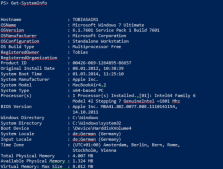使用Measure-Object和Compare-Object可以统计和对比管道结果。Measure-Object允许指定待统计对象的属性。Compare-Object可以对比对象前后的快照。
统计和计算
使用Measure-Object可以对对象的属性求最小值、最大值、平均值、和。例如要查看当前目录文件占用空间的情况。
|
1
2
3
4
5
6
7
8
9
10
11
12
13
14
15
|
PS C:Powershell> ls | measure lengthCount : 19Average :Sum :Maximum :Minimum :Property : lengthPS C:Powershell> ls | measure length -Average -Sum -Maximum -MinimumCount : 19Average : 53768.8421052632Sum : 1021608Maximum : 735892Minimum : 0Property : length |
使用Measure-Object还可以统计文本文件中的字符数,单词数,行数
例如我们可以把下面的文本保存到:word.txt 。
|
1
2
3
4
5
6
7
|
Retirement Anxiety Spreads Among the One PercentReport: Green Monday a Boon for Online Shopping5 Lesser-Known Ways to Boost Your Credit ScorePS C:Powershell> Get-Content .word.txt | measure -Line -Word -CharacterLines Words Characters Property----- ----- ---------- -------- 3 23 141 |
比较对象
有时需要比较前后两个时间段开启了那些进程,服务状态有什么变化。类似这样的工作可以交给Compare-Object。
比较不同的时间段
可以先将所有开启的进程信息快照保存到一个变量中,过一段时间,再保存一份新的进程快照,然后就可以通过Compare-Object进行对比了。
|
1
2
3
4
5
6
7
8
9
|
PS C:Powershell> $before=Get-ProcessPS C:Powershell> $after=get-processPS C:Powershell> Compare-Object $before $afterInputObject SideIndicator----------- -------------System.Diagnostics.Process (notepad) =>System.Diagnostics.Process (notepad) =>System.Diagnostics.Process (AcroRd32) |
$before 是一个数组存储了当前所有的Process对象,Compare-Object的结果有两个列:InputObject为前后不一致的对象,SideIndicator为不一致状态,=>表示新增的对象,结合上面的例子分析:在before和after的时间段有3个进程(AcroRd32,AcroRd32,prevhost)关闭了,有2个进程开启了(notepad,notepad)。
检查对象的变化
Compare-Object并不仅仅能比较对象组中的是否新增和减少了对象,它还可以比较每个对象的属性变化,因为它有一个参数-property 。
|
1
2
3
4
5
6
7
8
9
10
11
12
13
14
15
|
PS C:PowerShell> Get-Service wsearchStatus Name DisplayName------ ---- -----------Running wsearch Windows SearchPS C:PowerShell> $svc1=Get-Service wsearchPS C:PowerShell> $svc1.stop()PS C:PowerShell> $svc2=Get-Service wsearchPS C:PowerShell> Compare-Object $svc1 $svc2 -Property Status,Name Status Name SideIndicator ------ ---- ------------- StartPending wsearch => Running wsearch |
比较文件的内容
对于文本文件可以通过Get-Content进行读取,并且将文件以行为单位保存为一个数组,这时依然可以通过Compare-Object进行比较。下面的例子创建两个不同的文本文件,然后通过Compare-Object比较两个文件的Get-Content结果。
|
1
2
3
4
5
6
7
8
9
10
11
12
13
14
|
PS C:PowerShell> "Hellow>> Power>> Shell" >a.txt>>PS C:PowerShell> "Hollow>> Shell>> Linux" >b.txt>>PS C:PowerShell> Compare-Object (Get-Content .a.txt) (Get-Content .b.txt)InputObject SideIndicator----------- -------------Hollow =>Linux =>Hellow |
保存快照以便后期使用
上面的例子都是把对象保存在变量中,变量有一个缺点就是一旦Powershell退出或者电脑关闭变量都会消失。所以最好的方法就是把对象保存到磁盘文件中。怎样把对象序列化成一个文件,Powershell提供了一条命令:Export-Clixml,可以完成此工作,还有一条反序列化的命令Import-Clixml。这样可以使Compare-object的命令更方便。例如一个月前保存一个$before对象,一个月后比较都可以。
|
1
2
3
4
|
PS C:PowerShell> Get-Process | Export-Clixml before.xmlPS C:PowerShell> $before=Import-Clixml .before.xmlPS C:PowerShell> $after=Get-ProcessPS C:PowerShell> Compare-Object -ReferenceObject $before -DifferenceObject $after |







